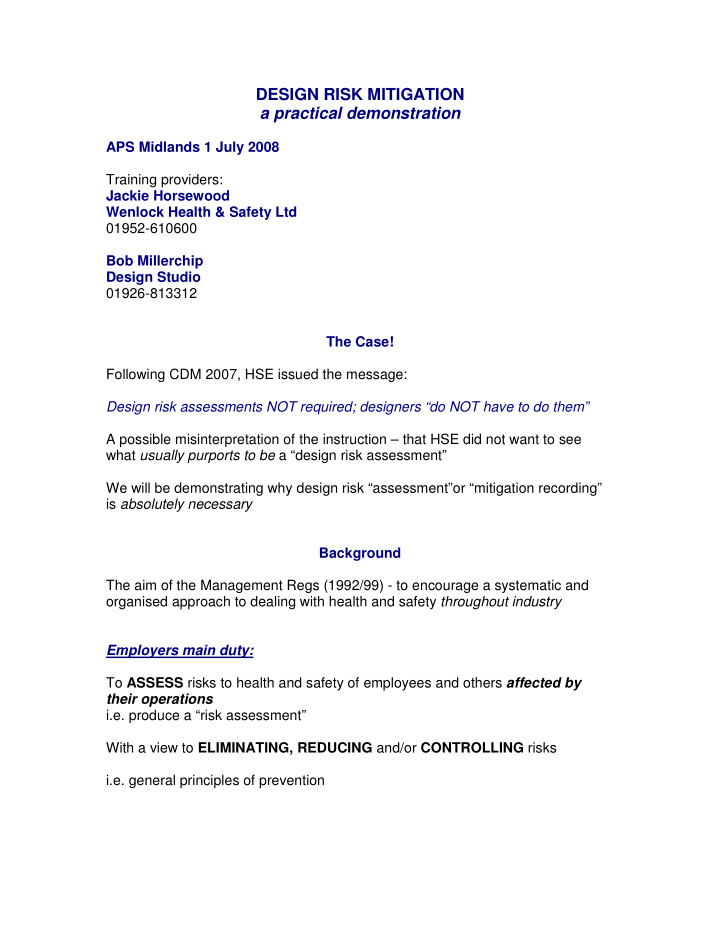



DESIGN RISK MITIGATION a practical demonstration APS Midlands 1 July 2008 Training providers: Jackie Horsewood Wenlock Health & Safety Ltd 01952-610600 Bob Millerchip Design Studio 01926-813312 The Case! Following CDM 2007, HSE issued the message: Design risk assessments NOT required; designers “do NOT have to do them” A possible misinterpretation of the instruction – that HSE did not want to see what usually purports to be a “design risk assessment” We will be demonstrating why design risk “assessment”or “mitigation recording” is absolutely necessary Background The aim of the Management Regs (1992/99) - to encourage a systematic and organised approach to dealing with health and safety throughout industry Employers main duty: To ASSESS risks to health and safety of employees and others affected by their operations i.e. produce a “risk assessment” With a view to ELIMINATING, REDUCING and/or CONTROLLING risks i.e. general principles of prevention
Builds on HSWA 1974 Section 6 – “It shall be the duty of any person who designs…….any article for use at work (a) to ensure so far as reasonably practicable that the article is so designed and constructed as to be safe and without risks to health ………(c)…( to ensure) that there will be available……..adequate information about the use…… and about any conditions necessary to ensure that, when put to that use, it will be safe and without risks to health ” Cannot satisfy Section 6 unless risks from site, concept and developing design “assessed” and conclusions recorded CDM 1994 Placed further specific duties on designers to pay due regard to the general principles of prevention during design Need to “assess” perceived – design risk assessments requested by planning supervisors and written by designers BUT, poor understanding of aims (mainly to satisfy PS’s requests!) Subsequently, generic; no beneficial substance; only informed “competent” contractors how to do their job. Insufficient relevant information about construction, end use or reasons for design decisions Hence DRAs usually very poor and the HSE’s message CDM 2007 Still specific duties on designers to pay due regard to the general principles of prevention during design (Reg.11) ACoP – what designers must do: “avoid foreseeable risks….” “ critically assess their design proposals at an early stage, and then throughout the design process…….” “ provide information about the aspects of the design that could create significant risks during future construction work or maintenance……..risks that are……not likely to be obvious, (are) unusual or likely to be difficult to manage”
CDM 2007 Clearly therefore THE INTERPRETATION OF THE HSE’S MESSAGE WAS CLEARLY INCORRECT And TRY PROVING YOUR CASE IN COURT WITHOUT DOCUMENTARY EVIDENCE!! So…………….. Where does that leave us? What is required? CDM 2007 To re-iterate: The ACoP states that designers must: “provide information about the aspects of the design that could create significant risks during future construction work or maintenance ……..risks that are……not likely to be obvious, (are) unusual or likely to be difficult to manage” Examples? CDM 2007 Work at height but is this a design or a contractor issue? Think about SIGNIFICANT work at height issues which may be usual or difficult for a COMPETENT contractor to realise or undertake Work at height what about design during end-use? Access for window cleaning? CDM 2007 Other issues? Excavations……………. Plant and vehicles……………. What about more mundane issues? What about hazardous substances?
CDM 2007 Even commonplace substances can cause misery……….. 1 on 10 bricklayers leaves the industry before the age of 40 Even commonplace substances can cause misery……….. This man lost his leg through concrete burns How can design help to avoid exposure? What about vibration? What about manual handling? What about manual handling in end use? What about emergency routes, particularly during refurbs? CDM 2007 The list is long and it is up to designers to: (a) be sufficiently health & safety competent to be able to consider relevant issues through design development (b) consider all such issues through design development E.g. consider how many risks can be reduced by pre-fabrication? CDM 2007 Consider this scheme………………….. how much risk could be attributed to the client and how much to the designer – imperative to record
Design Risk “Mitigation” Systems (What’s in a name??!!) The aim: (a) to ensure all aspects of health & safety are considered relevant to: construction maintenance cleaning end-use demolition (a) to provide an “audit trail” of design thought processes and conclusions Design Risk “Mitigation” Systems Objectives clear √ √ √ √ What to do clear √ √ √ √ What not to do clear √ √ √ √ Now consider – how best to achieve the goals (refer to suggested template and example)
Recommend
More recommend